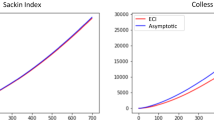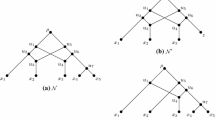Abstract
A phylogenetic tree represents historical evolutionary relationships between different species or organisms. The space of possible phylogenetic trees is both complex and exponentially large. Here we study combinatorial features of neighbourhoods within this space, with respect to four standard tree metrics. We focus on the splits of a tree: the bipartitions induced by removing a single edge from the tree. We characterize those splits appearing in trees that are within a given distance of the original tree, demonstrating close connections between these splits, the Whitney number of a tree, and the binary characters with a given parsimony length.
Similar content being viewed by others
Author information
Authors and Affiliations
Corresponding author
Additional information
AMS Subject Classification: 68R10, 05C05, 68Q25, 92D15.
Rights and permissions
About this article
Cite this article
Bryant, D. The Splits in the Neighborhood of a Tree. Ann. Combin. 8, 1–11 (2004). https://doi.org/10.1007/s00026-004-0200-z
Issue Date:
DOI: https://doi.org/10.1007/s00026-004-0200-z




